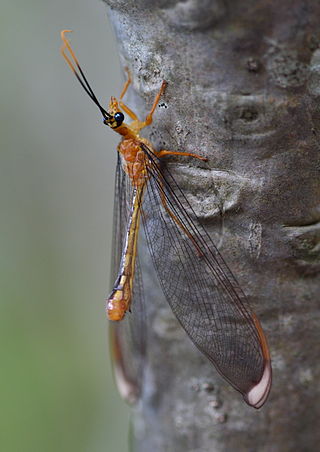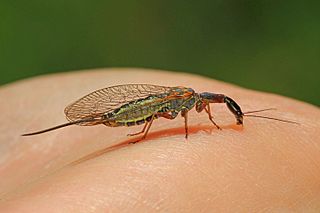
Green lacewings are insects in the large family Chrysopidae of the order Neuroptera. There are about 85 genera and 1,300–2,000 species in this widespread group. Members of the genera Chrysopa and Chrysoperla are very common in North America and Europe; they are very similar and many of their species have been moved from one genus to the other time and again, and in the nonscientific literature assignment to Chrysopa and Chrysoperla can rarely be relied upon. Since they are the most familiar neuropterans to many people, they are often simply called "lacewings". Since most of the diversity of Neuroptera are properly referred to as some sort of "lacewing", common lacewings is preferable.

Snakeflies are a group of predatory insects comprising the order Raphidioptera with two extant families: Raphidiidae and Inocelliidae, consisting of roughly 260 species. In the past, the group had a much wider distribution than it does now; snakeflies are found in temperate regions worldwide but are absent from the tropics and the Southern Hemisphere. Recognisable representatives of the group first appeared during the Early Jurassic. They are a relict group, having reached their apex of diversity during the Cretaceous before undergoing substantial decline.

Mantispidae, known commonly as mantidflies, mantispids, mantid lacewings, mantisflies or mantis-flies, is a family of small to moderate-sized insects in the order Neuroptera. There are many genera with around 400 species worldwide, especially in the tropics and subtropics. Only five species of Mantispa occur in Europe. As their names suggest, members of the group possess raptorial forelimbs similar to those of the praying mantis, a case of convergent evolution.

Osmylidae are a small family of winged insects of the net-winged insect order Neuroptera. The osmylids, also called lance lacewings, stream lacewings or giant lacewings, are found all over the world except North and Central America. There are around 225 extant species.

The Berothidae are a family of winged insects of the order Neuroptera. They are known commonly as the beaded lacewings. The family was first named by Anton Handlirsch in 1906. The family consists of 24 genera and 110 living species distributed discontinuously worldwide, mostly in tropical and subtropical regions. Numerous extinct species have also been described. Their ecology is poorly known, but in the species where larval stages have been documented, the larvae are predators of termites.

Nymphidae, sometimes called split-footed lacewings, are a family of winged insects of the order Neuroptera. There are 35 extant species native to Australia and New Guinea.

Psychopsidae is a family of winged insects of the order Neuroptera. They are commonly called silky lacewings.

Rhachiberothidae, sometimes called thorny lacewings, are a family of winged insects in the order Neuroptera. The family has only 14 extant species in four genera found in Sub-Saharan Africa, but has a diverse fossil record extending back to the Early Cretaceous in Lebanon, Eurasia and North America. Like the closely related Mantispidae members of the group possess raptorial forelegs, which probably only evolved once in the common ancestor of the groups.

The dustywings, Coniopterygidae, are a family of Pterygota of the net-winged insect order (Neuroptera). About 460 living species are known. These tiny insects can usually be determined to genus with a hand lens according to their wing venation, but to distinguish species, examination of the genitals by microscope is usually necessary.

Inocelliidae is a small family of snakeflies containing 8 genera of which one is known only from fossils. They are commonly known as inocelliid snakeflies. The largest known species is Fibla carpenteri known from fossils found in baltic amber.

Florissantoraphidia is an extinct genus of snakefly in the family Raphidiidae containing two described species Florissantoraphidia funerata and Florissantoraphidia mortua. Both species were originally placed in the living raphidiid genus Raphidia, as Raphidia funerata and Raphidia mortua respectively. before being redescribed and transferred to the newly erected genus in 2014.

Archiinocellia is an extinct genus of snakefly in the family Raphidiidae known from Eocene fossils found in western North America. The genus contains two species, the older Archiinocellia oligoneura and the younger Archiinocellia protomaculata. The type species is of Ypresian age and from the Horsefly Shales of British Columbia, while the younger species from the Lutetian Green River Formation in Colorado. Archiinocellia protomaculata was first described as Agulla protomaculata, and later moved to Archiinocellia.
Microberotha is an extinct monotypic genus of "beaded lacewing" in the family Berothidae known from a fossil found in North America. When described the genus contained a single Ypresian-age species Microberotha macculloughi.

Ithonidae, commonly called moth lacewings and giant lacewings, is a small family of winged insects of the insect order Neuroptera. The family contains a total of ten living genera, and over a dozen extinct genera described from fossils. The modern Ithonids have a notably disjunct distribution, while the extinct genera had a more global range. The family is considered one of the most primitive living neuropteran families. The family has been expanded twice, first to include the genus Rapisma, formerly placed in the monotypic family Rapismatidae, and then in 2010 to include the genera that had been placed into the family Polystoechotidae. Both Rapismatidae and Polystoechotidae have been shown to nest into Ithonidae sensu lato. The larvae of ithonids are grub-like, subterranean and likely phytophagous.

Agulla is a genus of modern snakeflies in the family Raphidiidae.

Puncha ratzeburgi is a species of snakefly in the monotypic genus Puncha belonging to the family Raphidiidae.

Nymphes is an Australian lacewing genus in the family Nymphidae.
This list of fossil arthropods described in 2009 is a list of new taxa of trilobites, fossil insects, crustaceans, arachnids and other fossil arthropods that have been described during the year 2009, as well as other significant discoveries and events related to arthropod paleontology that occurred.
This list of fossil arthropods described in 2011 is a list of new taxa of trilobites, fossil insects, crustaceans, arachnids and other fossil arthropods of every kind that have been described during the year 2011. The list only includes taxa at the level of genus or species.
The paleofauna of the Eocene Okanagan Highlands consists of Early Eocene arthropods, vertebrates, plus rare nematodes and molluscs found in geological formations of the northwestern North American Eocene Okanagan Highlands. The highlands lake bed series' as a whole are considered one of the great Canadian Lagerstätten. The paleofauna represents that of a late Ypresian upland temperate ecosystem immediately after the Paleocene-Eocene thermal maximum, and before the increased cooling of the middle and late Eocene to Oligocene. The fossiliferous deposits of the region were noted as early as 1873, with small amounts of systematic work happening in the 1880-90s on British Columbian sites, and 1920-30s for Washington sites. Focus and more detailed descriptive work on the Okanagan Highlands site started in the last 1970's. Most of the highlands sites are preserved as compression-impression fossils in "shales", but also includes a rare permineralized biota and an amber biota.
















